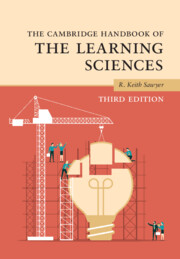Book contents
- The Cambridge Handbook of the Learning Sciences
- The Cambridge Handbook of the Learning Sciences
- Copyright page
- Contents
- Figures
- Tables
- Contributors
- Preface
- 1 An Introduction to the Learning Sciences
- Part I Foundations
- Part II Methodologies
- Part III Grounding Technology in the Learning Sciences
- 14 Video Games and Learning
- 15 Embodiment and Embodied Design
- 16 Tangible and Full-Body Interfaces in Learning
- 17 Augmented Reality in the Learning Sciences
- 18 Mobile Learning
- Part IV Learning Together
- Part V Learning Disciplinary Knowledge
- Part VI Moving Learning Sciences Research into the Classroom
- Index
- References
15 - Embodiment and Embodied Design
from Part III - Grounding Technology in the Learning Sciences
Published online by Cambridge University Press: 14 March 2022
- The Cambridge Handbook of the Learning Sciences
- The Cambridge Handbook of the Learning Sciences
- Copyright page
- Contents
- Figures
- Tables
- Contributors
- Preface
- 1 An Introduction to the Learning Sciences
- Part I Foundations
- Part II Methodologies
- Part III Grounding Technology in the Learning Sciences
- 14 Video Games and Learning
- 15 Embodiment and Embodied Design
- 16 Tangible and Full-Body Interfaces in Learning
- 17 Augmented Reality in the Learning Sciences
- 18 Mobile Learning
- Part IV Learning Together
- Part V Learning Disciplinary Knowledge
- Part VI Moving Learning Sciences Research into the Classroom
- Index
- References
Summary
This chapter reviews research showing that much learning involves physical movement and gesture – thinking and learning are embodied in the physical world and involve interactions with physical objects. Even abstract subjects such as math are better learned when the body is enlisted in the learning activity. Students often have trouble with STEM content because of pedagogy that removes the body from the learning experience. In fact, in many cases expert knowledge itself is embodied, more than is generally realized, and deeper learning requires embodied design. Embodied learning leads to deeper knowledge because the learner has to coordinate two cognitive and motor knowledge; manipulating symbolic notation is often quite similar to moving objects in space. The chapter discusses how to overcome challenges in designing activities, materials, and scaffolding.
- Type
- Chapter
- Information
- The Cambridge Handbook of the Learning Sciences , pp. 301 - 320Publisher: Cambridge University PressPrint publication year: 2022
References
- 1
- Cited by

